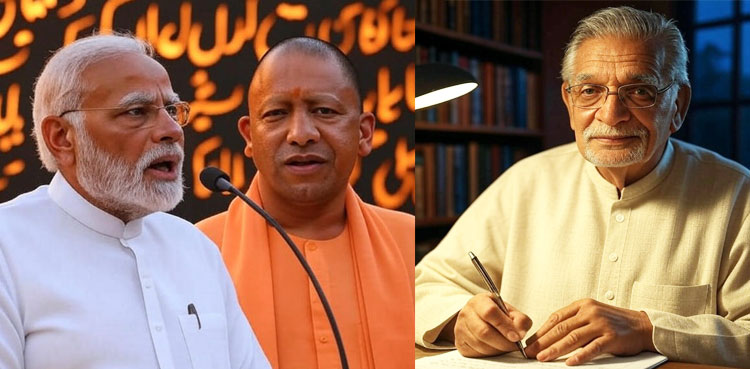Urdu, a language woven into the fabric of India’s cultural and historical identity, faces growing challenges under the current Bharatiya Janata Party (BJP) government. Critics argue that actions in BJP-ruled states, such as replacing Urdu with Sanskrit in Rajasthan’s school curriculum and removing Urdu-Persian terms from Uttar Pradesh’s registry documents, signal a deliberate attempt to marginalize the language.
These moves, coupled with political rhetoric framing Urdu as a symbol of “minority appeasement,” raise concerns about the erosion of India’s secular ethos and the potential loss to its vibrant art and film industries.
Urdu’s Historical and Cultural Significance
Urdu, an Eighth Schedule language under India’s Constitution, emerged from the cultural synthesis of the Indian subcontinent, blending Persian, Arabic, and local dialects. It has been a cornerstone of India’s literary heritage, from the poetry of Mirza Ghalib to the progressive writers’ movement that fueled the freedom struggle. Urdu’s influence extends to Bollywood, where its lyrical cadence shapes iconic songs and dialogues, and to regional cultures, where it thrives in states like Uttar Pradesh and Telangana. Despite its broad appeal across communities, Urdu language is often politicized as a “Muslim” language by right-wingers, making it a target in India’s polarized political landscape.
Evidence of Marginalization
Recent actions by BJP-led governments have sparked accusations of targeting Urdu language. In 2023, the Uttar Pradesh government, under Chief Minister Yogi Adityanath, replaced Urdu-Persian terms in registry documents with Hindi, framing it as administrative simplification. Critics, including AIMIM leader Asaduddin Owaisi, called it an attack on Urdu’s constitutional status (The Wire, 2023). In 2025, Rajasthan’s decision to replace Urdu with Sanskrit as the third language in government schools was labeled a “linguistic surgical strike” by detractors, who argued it sidelined Urdu-speaking students (Hindustan Times, 2025). In Karnataka, BJP leaders like CT Ravi and Sunil Kumar opposed Urdu’s inclusion in anganwadi teacher requirements and a Dussehra poetry event, respectively, associating it with “Muslim appeasement” (BBC, 2024). Even commercial use of Urdu, like FabIndia’s “Jashn-e-Riwaaz” Diwali campaign, faced backlash from BJP MP Tejasvi Surya, who called it an “Abrahamisation” of Hindu festivals, forcing its withdrawal (BBC, 2021).
While BJP leaders like Dinesh Sharma have called Urdu the “younger sister of Hindi” and some, like Haryana’s Manohar Lal Khattar, have supported its teaching, these gestures are overshadowed by a pattern of resistance. Historians like Audrey Truschke note that targeting Urdu aligns with a broader right-wing agenda to rewrite India’s history by erasing Muslim contributions, framing Urdu as a foreign import despite its indigenous roots (Truschke, 2023).
The Devastating Impact on India’s Secular Identity
Removing Urdu from curricula and public spaces threatens India’s secular identity, a cornerstone of its constitutional framework. Urdu is not exclusive to Muslims; it is spoken by diverse communities and represents a syncretic culture that blends Hindu, Muslim, and other influences. Suppressing it risks alienating millions, particularly in states where it enjoys official status, and fuels narratives of exclusion. The Supreme Court’s 2025 dismissal of a petition to ban Urdu on Maharashtra’s public signboards underscores its protected status, yet political rhetoric undermines this. By associating Urdu with “fanaticism,” as Yogi Adityanath did in 2025, the BJP risks deepening communal divides, eroding the pluralistic ethos that defines India.
Modi’s Support for Savarkar and Anti-Muslim Hindutva
Cultural and Artistic Losses
Urdu’s marginalization could also devastate India’s art and film industries. Bollywood, a global cultural ambassador, relies heavily on Urdu for its poetic dialogues and soulful music. Classics like Mughal-e-Azam and modern hits like Bajrangi Bhaijaan draw on Urdu’s emotive power. Restricting its presence in education and public life could stifle the next generation of lyricists, poets, and scriptwriters, diluting the industry’s creative output. Regional literary traditions, such as Urdu poetry festivals in Lucknow or Hyderabad, could wane, diminishing India’s cultural diversity.
While no centralized national policy explicitly targets Urdu, the cumulative effect of state-level actions and political rhetoric under the BJP suggests a troubling trend. Erasing Urdu from India’s history and curriculum not only undermines its secular identity but also risks impoverishing its cultural and artistic landscape. To preserve India’s pluralistic heritage, Urdu must be celebrated as a shared legacy, not sidelined as a political pawn.


Leave a Comment